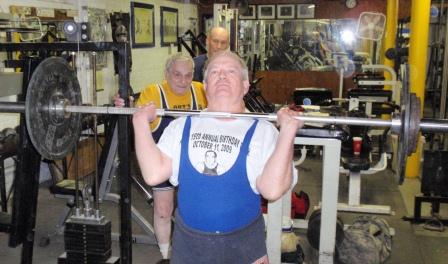HMB: THE LIFTER’S SUPPLEMENT?
Fact vs. Fiction and Hype
By Dan Wagman, PhD, CSCS
Publisher/Editor in Chief, Journal of Pure Power (JOPP)
I’m writing this because as a sports scientist, and dedicated barbell bender, I want people to understand that supplement companies realize that most of you hold science in high regard—which is why they use “science” to sell you their products. Of course they also cash in on the emotions and passions you hold for your sport; they know that you want to get the most out of your training and that you’ll leave no stone unturned. Unfortunately, most of the time you’re being taken advantage of. I’d like to share a recent experience with you that highlights this, in hopes that you’ll become a bit more wiser to the game that’s being played.
Background
I was recently contacted by a well-known strength athlete who receives sponsorship from a nutrition supplement company that specializes in β – h y d r o x y – β- m e t h y l b u t y r a t e, or simply HMB. In brief, HMB is a metabolite of the essential amino acid leucine (new research on this amino acid is reviewed in JOPP‘s January issue; (click here for a free sample). Both leucine and HMB have been shown to hold certain properties that could be beneficial to the strength athlete. But of course just holding such properties isn’t enough to conclude that your strength will go through the roof. After all, water holds essential properties our body needs, yet nobody would believe that by drinking more water before your attempt, you’ll end up increasing your Continental to Chest by 50 pounds. But that’s what research is for—investigating something under controlled conditions to see what’s actually occurring.
So this company’s claim is that HMB improves “strength, endurance, and recovery.” The company also claims that they’re all about “science instead of hype” and then go on to cite a lot of research on HMB with their own brief summaries thereof. From what I could tell, all of these research summaries are positive. And that’s where I got curious…
The Science
From previous study on HMB, I remembered that the research was equivocal. Why then, if this company was scientifically oriented, did they only list studies with positive results? In order to refamiliarize myself with the latest findings, and as a first step, I did a quick search of the scientific literature on HMB. Well, they’re still not in agreement on whether HMB will increase your performance or not. Now, before you take that as evidence that science is just a bunch of baloney, please understand that the reason for why studies aren’t always in agreement is because different research methods were used. It should come as no surprise that if you compare men to women, or an upper body exercise to a lower body exercise, or taking a supplement for seven days vs. seven weeks, etc., etc., that you’ll end up with conflicting results.
Anyway, my next step was to look at some of the research the company claims to be proof that HMB will increase performance. I randomly selected a study they cite. Here’s the company’s summary:
This randomized, double-blind, placebo-controlled study examined HMB supplementation in young male and female elite volleyball players for 7 wks. HMB supplementation resulted in improved body composition and significantly increased strength, while also decreasing fat mass percentage. HMB supplementation also increased peak and mean anaerobic power. No changes in hormones or inflammatory mediators were seen in this study.
Sounds good, but my next step was to look at the actual study, referenced below. A rather different picture emerged. First, the subjects were adolescents, as young as 13. That’s a huge flag because there’s an abundance of studies showing that adolescents respond to training, supplements, etc., quite differently than adults. Besides, can you really compare a 14-year old girl’s responses to HMB to that of a 36-year old male strength athlete? Next, the researchers used skinfold thickness to determine changes in fat-free mass, i.e., gains/losses in muscle mass. That method, however, isn’t the most accurate way to measure changes in muscle mass, especially in athletes and young people. In fact, the formula alone used for these calculations holds an error rate of nearly 4%. Consider that the placebo group showed changes ranging between 56.4 kg to 56.3 kg vs 59.3 kg to 61.6 kg for the HMB group. Though the HMB group showed statistically significant gains in muscle, in only considering the approximate 4% error rate for the formula, you end up with around 4.5 pounds (about 2 kg) worth of error. Since we’re talking about approximate error rates, and not even considering all sources of error in this method of determining fat-free mass, there’s no need for my math to be 100% accurate. The point is that you can easily see that as it relates to fat-free mass changes, HMB in this study isn’t much to hang your hat on.
But what about strength? That’s even more interesting. You see, the researchers found that the HMB group increased their strength significantly more than the placebo group—but only in knee flexion (such as in leg curls). No significant gains in strength were seen in knee extension, biceps curls, or triceps extensions. Now, also consider that strength was measured isokinetically. This means that equipment was used in which the speed of movement is held constant, in this case rep speed was measured at 180° and 60° per second. Of course any exercise you perform in the gym or competition isn’t isokinetic, it’s dynamic in that the speed of movement changes throughout the range of motion. So clearly, it’s difficult to generalize from an isokinetic curl to a dynamic squat. But again, please don’t dismiss the science because they used isokinetics to measure strength. You see, it’s very important to make sure that subjects perform an exercise identically, otherwise you introduce error into the experiment. If there’s any complaint on your part, it should be directed toward the supplement company for generating a false impression.
The research team also looked at peak and average anaerobic power via a cycle ergometer. Here some significant differences were noted for HMB. However, for rates of fatigue, aerobic fitness, or any of the hormonal and inflammatory measures taken, nothing significant was recorded allowing you to conclude that HMB might increase strength.
So how does this compare to the company’s summary? Not much. Add to that, that the research team discussed the various limitations of their work, all of which the company left out in their summary, and you can see how the company grossly exaggerated the study’s findings.
Take-Home Message
I’m sure you’re curious about this company’s name. But I’m not going to give it. Why? Because what I’ve shared with you is common among supplement companies. This particular company isn’t any worse than any of the other ones out there. So I feel that their particular name is irrelevant. The point is that you can’t trust any of them, even if they throw the word “science” around and list research. And even if the company employs scientists, that’s no guarantee, either. You see, last year I shined a bright light on how a company that produces mouthpieces and claims it’ll increase your strength, misrepresented what their scientists actually said (Click here and scroll down to Mouthpieces for Peak Performance?).
So are these companies purposely lying to you? That’s a tough question to answer. I would, however, say that they purposely hype their products to make sales. And what about HMB? Based on a quick review of the current science, my personal opinion is that you’d get more out of your training by focusing on a scientific approach thereto. And don’t forget about training the muscle between your ears; critical thinking and a healthy dose of scepticism when it comes to supplements is always in order.
Reference
Portal S., et al. The effect of HMB supplementation on body composition, fitness, hormonal and inflammatory mediators in elite adolescent volleyball players: a prospective randomized, double-blind, placebo-controlled study. European Journal of Applied Physiology. 111(9):2261-2269, 2011.


